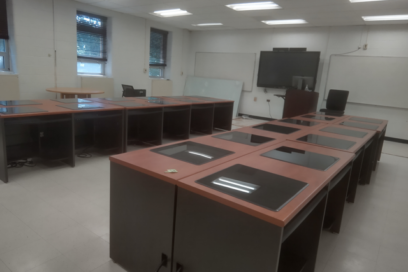Up until last semester, my classroom was filled with desks that were likely installed when everyone was using desktop computer towers. There was a place to drop the towers in and also space for a large monitor. With more students bringing their own laptops to class, the desks had fallen out of style and functionality pretty quickly.
A student in my development class was very in tune with the struggles I was facing with my learning space. I wanted a more collaborative space, and my classroom furniture was very restrictive. I also wanted to teach in a space that was user-friendly for my students, who would be going out into the workforce to participate in teamwork, work with technology and contribute productively to their companies.

A friendly offer changes a classroom atmosphere
As it happens, this student’s sister was coming into my program, and he would be graduating, but he approached me one day after class and mentioned that their father might be able to help. “I’m going to tell my dad about our classroom setup,” he said to me, “I think he can help with some computers, and let’s just see where it goes.” I agreed, with no intention of asking for anything except suggestions.
However, after our meeting, the father told me that he saw my vision and that a renovation was in order. He asked me to write up a list of everything I needed — and he even added flooring to the list, which I didn’t initially request — and we got to work fulfilling the classroom needs. We spent the summer going through lists of potential vendors, selected MiEN, ordered everything and were up and running with our renovated classroom last semester.
I took five steps to ensure that the upgraded space met the needs of my students.
- Know your own priorities. I’ve labeled myself an active teacher, which means we do hands-on assignments in the classroom. Students are on the computer, engaging in activities, collaborating with team members and staying connected. I needed a classroom that represented and supported that instructional style.
- Make a wish list. Mine included desks that could be moved around the room easily and used individually or for group work. I also wanted a timeless and bright color palette plus a lectern, cabinet, computer shelf and a laptop charging station.
- Consider life after college. When students go out into the business world, they will be expected to collaborate, work together and contribute at high levels. Individual, traditional desks no longer translate well in the work world. Students now can sit at collaborative tables and work in groups. They’re fully engaged and involved in a hands-on space that mimics what’s happening in the work world.
- Don’t forget charging and storing. With the inclusion of new flooring, we were able to put receptacles in the floor. Each student has a space where they can charge their devices, with a charging station as the primary source and the floor receptacles for backup. I also included shelf space for storing the school’s laptops when they’re not in use.
- Pick a great design partner. Our furniture partner was very accommodating and stayed in close contact with me throughout the entire classroom upgrade process. I really liked being able to pick the colors, materials and finishings for the new furniture, which meant fewer surprises upon delivery. When it came time to install the furniture, our partner handled it all.
Settling into a collaborative space
Now when students come into the classroom, they can sit at connected desks to work in groups or claim their own space and get to the coursework at hand — it’s their choice. My hope is that I’m doing everything possible to prepare them for post-graduation success, and I owe it all to a wonderful student who wasn’t afraid to step up and foster support where it was needed.
DeShea Simon, Ph.D., is an assistant professor of information systems at Hampton University, James T. George School of Business in Hampton, Va.
